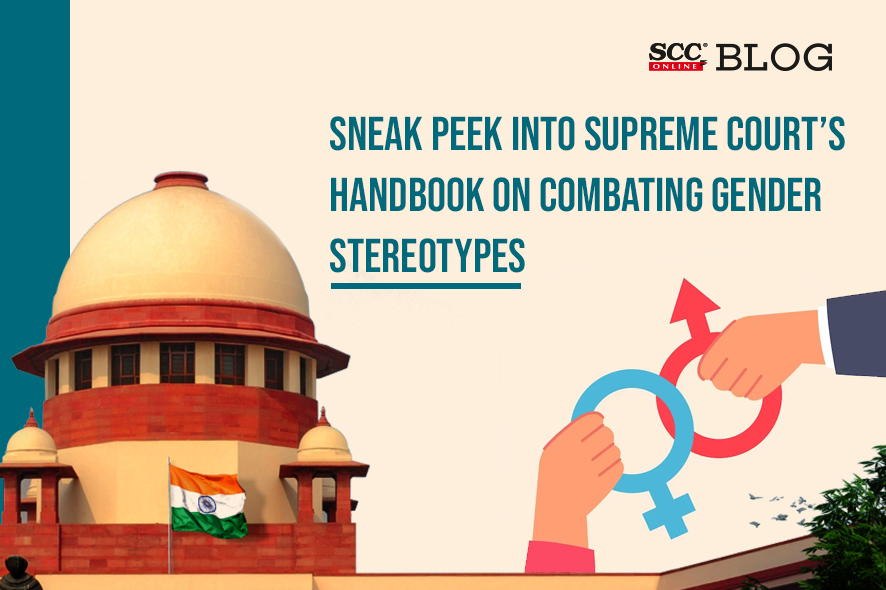The Supreme Court on 16-08-2023 released a ‘Handbook on Combating Gender Stereotypes’ which aims at assisting judges and legal community for identifying, understanding and combating stereotypes about women. It particularly attacks the ‘gender-unjust terms’ and suggests alternative words or phrases to be used while drafting pleadings as well as orders and judgments. It pokes the stereotypical approach and also unveils the reality behind such stereotypes.
The foreword by Chief Justice of India, Dr. Dhananjaya Y. Chandrachud explained the importance of keeping safe from gender stereotypes during judicial decision making that “A judge’s oath demands rejecting improper attempts to influence their decision-making. The oath also requires a judge to put aside any preconceived notions about the parties before the court. Relying on predetermined stereotypes in judicial decision-making contravenes the duty of judges to decide each case on its merits, independently and impartially. In particular, reliance on stereotypes about women is liable to distort the law’s application to women in harmful ways.”
Judges versus Gender Stereotypes
As mentioned earlier, the Supreme Court’s handbook on Combating Gender Stereotypes specifically upheld the importance of avoiding stereotypes by judges. It elucidates that “With respect to the judiciary, it is vital that judges not only avoid relying on stereotypes in their decision making and writing, but also actively challenge and dispel harmful stereotypes. If harmful stereotypes are relied on by judges, it can lead to a distortion of the objective and impartial application of the law”
The Handbook on Combating Gender Stereotypes released by Supreme Court helps with the following:
-
Identifying language that promotes gender stereotypes and offering alternative words and phrases;
-
Identifying common reasoning patterns that are based on gender stereotypes (particularly about women) and discussing why they are incorrect;
-
Highlighting binding decisions of the Supreme Court of India that have rejected these stereotypes and can be utilised by judges to dispel gender stereotypes.
Suggested Language in Supreme Court’s Handbook
|
Stereotype promoting language (Incorrect) |
Alternative language (Preferred) |
|
Affair |
Relationship outside of marriage |
|
Concubine / keep |
Woman with whom a man has had romantic or sexual relations outside of marriage |
|
Chaste woman |
Woman |
|
Child prostitute |
Child who has been trafficked |
|
Eve teasing |
Street sexual harassment |
|
Forcible rape |
Rape |
|
Hooker/Prostitute |
Sex worker |
|
Ladylike |
Use a gender-neutral description of behaviour or characteristics (e.g., amusing or assertive) |
|
Marriageable age |
A woman who has attained the legal age required to marry |
|
Mistress |
Woman with whom a man has had romantic or sexual relations outside of marriage |
|
Unwed Mother |
Mother |
|
Woman of loose morals / easy virtue / promiscuous woman / wanton woman/ whore |
Woman |
|
Violated (e.g., he violated her) |
Sexually harassed / assaulted or raped |
|
Provocative clothing / dress |
Clothing / dress |
|
Ravished (e.g., she was “ravished” by him) |
Sexually harassed / assaulted or raped |
|
Survivor or Victim? An individual who has been affected by sexual violence may identify themselves as either a “survivor” or “victim”. Both terms are applicable unless the individual has expressed a preference, in which case the individual’s preference should be respected. |
|
Insights on the Handbook
The Supreme Court’s handbook on Combating Gender Stereotypes defines stereotypes as “a set idea that people have about what someone or something is like, especially an idea that is wrong”, gives a glimpse of how stereotypes function, and their impact on judicial decision making. It categorizes the different types of gender stereotypes as:
-
Stereotypes based on the so-called ‘inherent characteristics’ of women;
-
Stereotypes based on gender roles;
-
Stereotypes concerning sex and sexual violence
Supreme Court’s Comparison of Stereotypes and Reality
|
Stereotype |
Reality |
|
All women are physically weaker than all men |
While men and women are physiologically different, it is not true that all women are physically weaker than all men. A person’s strength does not depend solely on their gender but also on factors such as their profession, genetics, nutrition, and physical activity. |
|
Women are warm, kind, and compassionate. |
Compassion is an acquired characteristic that is unique to every individual. Individuals of all genders can possess (or not possess) compassion. |
|
Women are more nurturing and better suited to care for others |
People of all genders are equally suited to the task of caring for others. Women are often socially conditioned to care for others from a young age. Many women are also forced to abandon their careers to care for children and the elderly. |
|
Women who do not work outside the home do not contribute to the household or contribute very little in comparison to their husbands. |
Women who are homemakers perform unpaid domestic labour (such as cooking, cleaning, washing, household management, accounts) and care work (such as caring for the elderly and for children, helping children with their homework and extracurriculars). The unpaid labour performed by women not only contributes to the household’s quality of life but also results in monetary savings. Women who are homemakers contribute to the household to an equal (or greater) extent. Their contributions are often overlooked because men are conditioned to believe that such work is of limited value. |
|
Women who dress in clothes that are not considered to be traditional want to engage in sexual relations with men. If a man touches such a woman without her consent, it is her fault |
The clothing or attire of a woman neither indicates that she wishes to engage in sexual relations nor is it an invitation to touch her. Women are capable of verbally communicating with others and their choice of clothing represents a form of self-expression that is independent of questions of sexual relations. A man who touches a woman without her consent must not be permitted to take the defense that the woman invited his touch by dressing in a particular way. |
|
Women who are sexually assaulted or raped by men cry incessantly and are depressed or suicidal. If a woman’s behaviour does not conform to this mould, she is lying about having been raped |
Different people react differently to traumatic events. For example, the death of a parent may cause one person to cry publicly whereas another person in a similar situation may not exhibit any emotion in public. Similarly, a woman’s reaction to being sexually assaulted or raped by a man may vary based on her individual characteristics. There is no “correct” or “appropriate” way in which a survivor or victim behaves. |
|
Women who are sexually assaulted or raped by men complain about the injustice immediately. If they complain after a time, they are lying. |
It takes courage and strength to report a sexual offence because of the stigma attached to them. The stigma attached to sexual violence makes it difficult for women to disclose the incident to others. Women may therefore register a complaint after a lapse of some time, when she thinks she is able to. Further, as noted above, several other factors such as lack of familial support or fear of repercussions may cause a survivor / victim to delay their reporting. |
|
Men are unable to control their sexual desires. |
Men, like all other humans, are in control of all their actions including their sexual desires. Such reasoning discounts the agency of men and then excuses this purported lack of agency |
|
“Good” women prefer death rather than being raped by a man. |
It is a patriarchal and harmful belief that women should prefer death rather than being raped by a man. Such beliefs may cause survivors / victims to consider suicide because they have been raped by a man. |
|
Transgender individuals cannot be raped. |
Transgender individuals can be raped. In fact, transgender individuals are one of the groups which are most vulnerable to sexual violence because they are stigmatized and face structural discrimination. It is incorrect to assume that all transgender individuals are sex workers who always consent to sexual relations. |
Handbook’s Highlights on Precedents Targeting Stereotypes
-
Adultery stroke down in Joseph Shine v. Union of India, (2019) 3 SCC 39
-
Two-finger test banned in State of Jharkhand v. Shailendra Kumar Rai, 2022 SCC OnLine SC 1494
-
Inherent credibility of survivor/victim’s testimony in State of Punjab v. Gurmit Singh, (1996) 2 SCC 384
-
Contextual evaluation of absence of physical injuries in State of U.P. v. Chhotey Lal, (2011) 2 SCC 550
-
Restricted mechanical use of delay in filing FIR/complaint to create doubt in State of Punjab v. Gurmit Singh, (1996) 2 SCC 384 as reiterated in several decisions including State of H.P. v. Gian Chand, (2001) 6 SCC 71
Conclusion
In its conclusion, it was beautifully acknowledged that the handbook primarily focused on gender stereotypes concerning women, and that it is important to realize that stereotypes impact individuals from across the gender spectrum, while stating that “Judges must be vigilant against all forms of gender biases and ensure that every person, regardless of their gender identity, is treated equally and with dignity before the law.” Impact is a secondary aspect, but the Supreme Court’s Handbook on Combating Gender Stereotypes is an eye-opener and a must read for everyone among and beyond the legal community.








I just read the article on the Supreme Court’s handbook for combating gender stereotypes, and I’m truly appreciative of the efforts being made to promote gender equality and challenge stereotypes. This initiative is a significant step towards a more just and inclusive society.